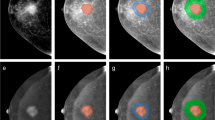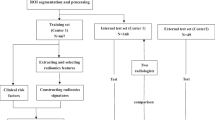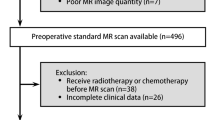Abstract
Objective
This study aims to establish and validate a radiomics nomogram based on contrast-enhanced spectral mammography (CESM) for prediction of axillary lymph node (ALN) metastasis in breast cancer.
Methods
This retrospective study included 394 patients with breast cancer who underwent CESM examination in two hospitals. The least absolute shrinkage and selection operator (LASSO) logistic regression was established for feature selection and utilized to construct radiomics signature. The nomogram model included the radiomics signature and independent clinical factors. The receiver operating characteristic (ROC) curves were used to confirm the performance of the nomogram in training and validation sets.
Results
The nomogram model, which includes the radiomics signature and the CESM-reported lymph node status, has areas under the ROC curves of 0.774 (95% confidence interval (CI) 0.689–0.858), 0.767 (95% CI 0.583–0.857), and 0.79 (95% CI 0.63–0.94) in the training, internal validation, and external validation sets, respectively. We identified the cutoff score in the radiomics nomogram as − 1.49, which corresponded to a total point of 49 that could diagnose ALN metastasis with a sensitivity of > 95%.
Conclusions
The CESM-based radiomics nomogram is a noninvasive predictive tool that shows good application prospects in the preoperative prediction of ALN metastasis in breast cancer.
Key Points
• The CESM-based radiomics nomogram shows good performance in predicting ALN metastasis in breast cancer.
• The application of radiomics nomogram in this study provides a new approach for establishing a prediction model with multiple characteristics.
• The nomogram has good application prospects in assisting clinical decision makers.




Similar content being viewed by others
Abbreviations
- ALN:
-
Axillary lymph node
- AUC:
-
Area under the curve
- CESM:
-
Contrast-enhanced spectral mammography
- GLCM:
-
Gray-level co-occurrence matrix
- GLSZM:
-
Gray-level size zone matrix (form factor matrix)
- ICC:
-
Intraclass correlation coefficient
- LASSO:
-
Least absolute shrinkage and selection operator
- RLM:
-
Run length matrix
- ROC:
-
Receiver operating characteristic
- ROI:
-
Region of interest
References
Kootstra J, Hoekstra-Weebers JE, Rietman H et al (2008) Quality of life after sentinel lymph node biopsy or axillary lymph node dissection in stage I/II breast cancer patients: a prospective longitudinal study. Ann Surg Oncol 15:29–29
Zhao J, Zhang J, Zhu QL et al (2018) The value of contrast-enhanced ultrasound for sentinel lymph node identification and characterisation in pre-operative breast cancer patients: a prospective study. Eur Radiol 28(4):1654–1661
Sodano C, Clauser P, Dietzel M et al (2020) Clinical relevance of total choline (tCho) quantification in suspicious lesions on multiparametric breast MRI. Eur Radiol 30(6):3371–3382
Fusco R, Sansone M, Granata V et al (2018) Use of quantitative morphological and functional features for assessment of axillary lymph node in breast dynamic contrast-enhanced magnetic resonance imaging. Biomed Res Int 2018:2610801
Dietzel M, Baltzer PAT, Vag T et al (2010) Application of breast MRI for prediction of lymph node metastases - systematic approach using 17 individual descriptors and a dedicated decision tree. Acta Radiol 51(8):885–894
Luczynska E, Heinze-Paluchowska S, Dyczek S, Blecharz P, Rys J, Reinfuss M (2014) Contrast-enhanced spectral mammography: comparison with conventional mammography and histopathology in 152 women. Korean J Radiol 15(6):689–696
Gillies RJ, Kinahan PE, Hricak H (2016) Radiomics: images are more than pictures, they are data. Radiology 278(2):563–577
Lambin P, Rios-Velazquez E, Leijenaar R et al (2012) Radiomics: extracting more information from medical images using advanced feature analysis. Eur J Cancer 48(4):441–446
Aerts HJWL, Velazquez ER, Leijenaar RTH et al (2014) Decoding tumour phenotype by noninvasive imaging using a quantitative radiomics approach. Nat Commun 5:4006
Birkhahn M, Mitra AP, Cote RJ (2007) Molecular markers for bladder cancer: the road to a multimarker approach. Expert Rev Anticancer Ther 7(12):1717–1727
Vellinga TT, Kranenburg O, Frenkel N et al (2017) Lymphangiogenic gene expression is associated with lymph node recurrence and poor prognosis after partial hepatectomy for colorectal liver metastasis. Ann Surg 266(5):765–771
Gorelik E, Landsittel DP, Marrangoni AM et al(2005) Multiplexed immunobead-based cytokine profiling for early detection of ovarian cancer. Cancer Epidemiol Biomarkers Prev 14(4):981–987
Paik S, Shak S, Tang G et al (2004) A multigene assay to predict recurrence of tamoxifen-treated, node-negative breast cancer. N Engl J Med 351(27):2817–2826
Sparano JA, Gray RJ, Makowe DF et al (2015) Prospective validation of a 21-gene expression assay in breast cancer. N Engl J Med 373(21):2005–2014
Dihge L, Bendahl PO, Ryden L (2017) Nomograms for preoperative prediction of axillary nodal status in breast cancer. Br J Surg 104(11):1494–1505
Huang YQ, Liang CH, He L et al (2016) Development and validation of a radiomics nomogram for preoperative prediction of lymph node metastasis in colorectal cancer. J Clin Oncol 34(18):2157–2164
Wu S, Zheng J, Li Y et al (2017) A radiomics nomogram for the preoperative prediction of lymph node metastasis in bladder cancer. Clin Cancer Res 23(22):6904–6911
Valente SA, Levine GM, Silverstein MJ et al (2012) Accuracy of predicting axillary lymph node positivity by physical examination, mammography, ultrasonography, and magnetic resonance imaging. Ann Surg Oncol 19(6):1825–1830
Mortellaro VE, Marshall J, Singer L et al (2009) Magnetic resonance imaging for axillary staging in patients with breast cancer. J Magn Reson Imaging 30(2):309–312
Yoshimura G, Sakurai T, Oura S et al (1999) Evaluation of axillary lymph node status in breast cancer with MRI. Breast Cancer 6(3):249–258
Collewet G, Strzelecki M, Mariette F (2004) Influence of MRI acquisition protocols and image intensity normalization methods on texture classification. Magn Reson Imaging 22(1):81–91
Gibbs P, Turnbull LW (2003) Textural analysis of contrast-enhanced MR images of the breast. Magn Reson Med 50(1):92–98
Depeursinge A, Foncubierta-Rodriguez A, Van De Ville D, Muller H (2014) Three-dimensional solid texture analysis in biomedical imaging: review and opportunities. Med Image Anal 18(1):176–196
Sauerbrei W, Royston P, Binder H (2007) Selection of important variables and determination of functional form for continuous predictors in multivariable model building. Stat Med 26(30):5512–5528
Yu A, Wang S, Cheng X et al (2017) Functional connectivity of motor cortical network in patients with brachial plexus avulsion injury after contralateral cervical nerve transfer: a resting-state fMRI study. Neuroradiology 59(3):247–253
Luini A, Gatti G, Ballardini B et al (2005) Development of axillary surgery in breast cancer. Ann Oncol 16(2):259–262
Cianfrocca M, Goldstein LJ (2004) Prognostic and predictive factors in early-stage breast cancer. Oncologist 9(6):606–616
Balachandran VP, Gonen M, Smith JJ, DeMatteo RP (2015) Nomograms in oncology: more than meets the eye. Lancet Oncol 16(4):e173–e180
Dong Y, Feng Q, Yang W et al (2018) Preoperative prediction of sentinel lymph node metastasis in breast cancer based on radiomics of T2-weighted fat-suppression and diffusion-weighted MRI. Eur Radiol 28(2):582–591
Cui X, Wang N, Zhao Y et al (2019) Preoperative prediction of axillary lymph node metastasis in breast cancer using radiomics features of DCE-MRI. Sci Rep 9(1):2240
Yang J, Wang T, Yang L et al (2019) Preoperative prediction of axillary lymph node metastasis in breast cancer using mammography-based radiomics method. Sci Rep 9(1):4429
Lee M, Woo B, Kuo MD, Jamshidi N, Kim JH (2017) Quality of radiomic features in glioblastoma multiforme: impact of semi-automated tumor segmentation software. Korean J Radiol 18(3):498–509
Jung SC, Choi SH, Yeom JA et al (2013) Cerebral blood volume analysis in glioblastomas using dynamic susceptibility contrast-enhanced perfusion MRI: a comparison of manual and semiautomatic segmentation methods. PLoS One 8(8):e69323
de Hoop B, Gietema H, van Ginneken B, Zanen P, Groenewegen G, Prokop M (2009) A comparison of six software packages for evaluation of solid lung nodules using semi-automated volumetry: what is the minimum increase in size to detect growth in repeated CT examinations. Eur Radiol 19(4):800–808
Mazurowski MA (2015) Radiogenomics: what it is and why it is important. J Am Coll Radiol 12(8):862–866
Dietzel M, Baltzer PAT, Dietzel A et al (2010) Application of artificial neural networks for the prediction of lymph node metastases to the ipsilateral axilla - initial experience in 194 patients using magnetic resonance mammography. Acta Radiol 51(8):851–858
Zhou LQ, Wu XL, Huang SY et al (2020) Lymph node metastasis prediction from primary breast cancer US images using deep learning. Radiology 294(1):19–28
Funding
This study was supported by the Shandong Medical and Health Science and Technology Development Plan (2016WS0713), Natural Science Foundation of Shandong Province of China (ZR2017PH043, ZR2017LH053), Natural Science Foundation of China (81671654), and Special Fund of China Medical Education Association (2016SKT-M034).
Author information
Authors and Affiliations
Corresponding authors
Ethics declarations
Guarantor
The scientific guarantor of this publication is Haizhu Xie.
Conflict of interest
Two of the authors of this manuscript (Shaofeng Duan, Xuexi Zhang) are employees GE Healthcare. The remaining authors declare no relationships with any companies whose products or services may be related to the subject matter of the article.
Statistics and biometry
One of the authors, Shaofeng Duan, has significant statistical expertise.
Informed consent
Written informed consent was waived by the institutional review board.
Ethical approval
Institutional review board approval was obtained.
Additional information
Publisher’s note
Springer Nature remains neutral with regard to jurisdictional claims in published maps and institutional affiliations.
Rights and permissions
About this article
Cite this article
Mao, N., Yin, P., Li, Q. et al. Radiomics nomogram of contrast-enhanced spectral mammography for prediction of axillary lymph node metastasis in breast cancer: a multicenter study. Eur Radiol 30, 6732–6739 (2020). https://doi.org/10.1007/s00330-020-07016-z
Received:
Revised:
Accepted:
Published:
Issue Date:
DOI: https://doi.org/10.1007/s00330-020-07016-z




